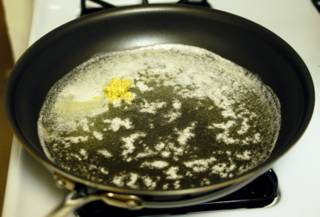In the United States, shrimp is sold by "count". This is a rating of the size and weight of the shrimp. The count represents the number of shrimp in a pound for a given size category. For example, 41-50 count shrimp are composed of shrimp that weigh about 1/3 ounce each, while 16-20 count shrimp are an ounce each (or a little less) in weight. The lower the count, the larger the shrimp (and the more expensive).
Bring six quarts of water in a large pot to a boil. While waiting for the water to boil, peel one pound of shrimp, leaving tails on. Butterfly the shrimp by cutting the backs of each shrimp. While butterflying I also remove the vein (I think it's actually the alimentary canal) to avoid having gritty shrimp waste in my scampi. Rinse the shrimp and blot dry with paper towels. Once the water is boiling, stir in 1/2 tablespoon table salt and add one pound of dried linguine. (Cooking times for pasta varies by manufacturer. Use the instructions on the box, but be aware that many pasta manufacturers recommend cooking times that are to long for al dente. I suggest subtracting a few minutes from the cooking time and testing the pasta by biting down on it and looking at the cross section. There should still be a tiny speck of uncooked pasta when the noodles are al dente. Drain the pasta immediately; they will finish cooking as they stand.)
 Melt four tablespoons of butter and two tablespoons of olive oil in the pan. Add about 2 teaspoons of minced garlic and 1/4 teaspoon salt (if using unsalted butter). Stir over medium-low heat until the garlic is lightly browned.
Melt four tablespoons of butter and two tablespoons of olive oil in the pan. Add about 2 teaspoons of minced garlic and 1/4 teaspoon salt (if using unsalted butter). Stir over medium-low heat until the garlic is lightly browned. The shrimp should be added in a single layer on the pan (cook two batches if necessary). The shrimp can be cooked over low or medium heat. Over medium heat, the shrimp will form a slight crust and be golden brown when cooked. When the shrimp color changes and the flesh touching the pan is no longer translucent (about two minutes), flip the shrimps over with a pair of tongs or spatula.
The shrimp should be added in a single layer on the pan (cook two batches if necessary). The shrimp can be cooked over low or medium heat. Over medium heat, the shrimp will form a slight crust and be golden brown when cooked. When the shrimp color changes and the flesh touching the pan is no longer translucent (about two minutes), flip the shrimps over with a pair of tongs or spatula. Meanwhile, when the linguine is cooked to the desired level, pour the pasta into a collander to drain. Return the pasta to the pot or into a large bowl. When the second side of the shrimp is fully cooked (another two minutes), throw in one tablespoon chopped parsley and give it a quick stir. Remove from the heat and pour shrimp and butter over the pasta. Toss and serve with fresh grated parmesan, ground black pepper, and a slice of lemon.
Meanwhile, when the linguine is cooked to the desired level, pour the pasta into a collander to drain. Return the pasta to the pot or into a large bowl. When the second side of the shrimp is fully cooked (another two minutes), throw in one tablespoon chopped parsley and give it a quick stir. Remove from the heat and pour shrimp and butter over the pasta. Toss and serve with fresh grated parmesan, ground black pepper, and a slice of lemon.Shrimp Scampi
| 1 lb. shrimp | cook until opaque | flip; cook until opaque | add | ||
| 4 Tbs. butter | melt | brown | |||
| 2 Tbs. olive oil | |||||
| 1/4 tsp. salt | |||||
| 2 tsp. minced garlic | |||||
| 1 Tbs. chopped parsley | |||||
No comments:
Post a Comment